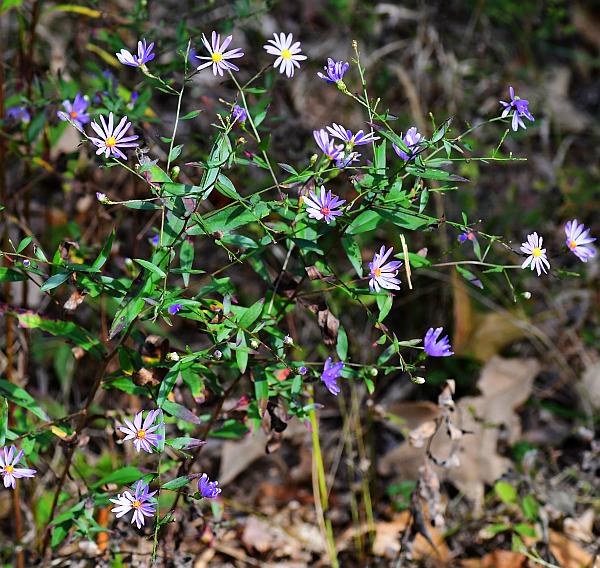Symphyotrichum turbinellum (Lindl.) G.L. Nesom
Prairie Aster

Native
CC = 6
CW = 5
MOC = 75
© SRTurner
Symphyotrichum turbinellum (Lindl.) G.L. NesomPrairie Aster | |
 |
Native CC = 6 CW = 5 MOC = 75 |
© SRTurner |
|
Family - Asteraceae/Astereae Habit - Perennial forb with a compact, woody, sometimes short-branched, usually horizontal rootstock. Stem - Spreading to ascending, to 1.2 m, single or multiple, usually branched, sparsely pubescent toward the tip with spreading, often stout and stiff (sandpapery) hairs, these often in lines, usually glabrous toward the base.
Leaves - Alternate, simple, sessile to short-petiolate. Basal and lower stem leaves often absent at flowering. Stem leaves to 12 cm long and 2 cm wide, narrowly oblanceolate, elliptic, or oblong, tapered at base, the margins entire or sparsely toothed, the upper surface glabrous and somewhat glossy, the undersides glabrous except along midvein. Upper stem leaves reduced, sessile but not clasping.
Inflorescences - Open panicles of heads, sometimes with relatively long, loosely racemose branches, the heads appearing mostly long-stalked, the bracts usually noticeably shorter and narrower than the adjacent foliage leaves, 0.2-0.7 cm long, narrowly lanceolate to more commonly linear.
Heads - Radiate, mostly 2-3 cm in diameter. Involucre 7-12 mm long, the bracts in 6-9 unequal, overlapping series. Involucral bracts narrowly oblong-oblanceolate to oblanceolate, rounded or broadly angled to a bluntly pointed and ascending tip, the base somewhat thickened and keeled, the slender midvein broadened relatively abruptly in the apical 1/5-1/3 into a broadly elliptic to diamond-shaped or obovate green tip, the outer surface glabrous or less commonly sparsely hairy toward the tip, the margins usually finely hairy, especially toward the tip.
Flowers - Ray florets 14-20 in 1 series, pistillate, the corollas well developed, 10-16 mm long, lavender to purple to bluish purple. Disc florets 15-30, perfect, yellow turning reddish-brown after pollination, the corollas 4.5-6.5 mm long, the slender portion of the tube shorter than the slightly expanded apical portion, the lobes 0.6-0.9 mm long, 17-22 percent of the total length of the expanded portion. Pappus bristles 4.5-6.0 mm long, off-white to light tan.
Fruits - Achenes 2-3 mm long, with 4 or 5 longitudinal ribs, purplish brown to brown, sparsely hairy. Flowering - August - November. Habitat - Forest openings, savannas, glades, ledges and tops of bluffs, railroads, roadsides. Prefers acidic substrates. Origin - Native to the U.S. Midwest. Other info. - This aster occurs throughout much of Missouri, though it is apparently absent from the northwestern quadrant of the state and a portion of the central Ozarks. Missouri is at the center of the plant's natural range, which extends to only a few surrounding states. It is a relatively easy aster to recognize, having long involucres and elliptic leaves with tapered bases. The plants tend to have a branched, open habit. The species does well in cultivation. It is showy with relatively large heads and is worthy of more frequent cultivation in gardens and landscapes. Photographs taken at Taum Sauk State Park, Iron County, MO, 9-27-2010 and 9-19-2012, Shaw Nature Reserve, Franklin County, MO, 10-4-2016, and Little Lost Creek Conservation Area, Warren County, MO, 10-9-2020 (SRTurner). |